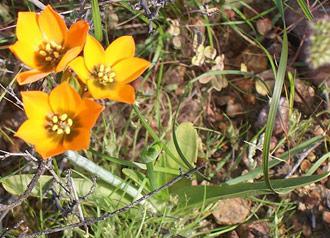Ornithogalum dubium
Ornithogalum dubium Houtt.
Family: Hyacinthaceae
Common names: yellow chincherinchee (Eng.); geeltjienkerientjee, geeltjienk (Afr.); itsweletswele lasethafeni (Xhosa)
Introduction
Ornithogalum dubium is a long-blooming, showy plant with beautiful large flowers, ideal for growing in pots, and as a cut flower.

Description
Description
This bulbous plant grows 100-500 mm tall. It has 3-8 linear leaves which can be erect or spreading. The leaf margins are minutely hairy. The flowers are yellow to orange and rarely white, often with a brown or green centre. The style is very short. The fruit capsule is rounded, deeply 3-angled and prominently ribbed. The seeds are discoid, black and shiny. The flowers appear from August to December. This is a summer deciduous plant, i.e. it starts growing in autumn when the winter rains start and dies back after flowering in spring when the hot summer weather begins.

Conservation Status
Status
Ornithogalum dubium is classified as Least Concern (LC) on the Red List of South African plants. It is widespread and very common.
Distribution and habitat
Distribution description
There are about 120 species of Ornithogalum in Africa, Europe and western Asia. Ornithogalum dubium occurs in the Western and Eastern Cape of South Africa. The distribution of O. dubium ranges from Clanwilliam to Paarl and Caledon to Port Elizabeth. It grows on mountain slopes and flats, in stony clay soil.
Derivation of name and historical aspects
History
Ornithogalum is derived from the Greek words ornis meaning 'bird' and gala meaning 'milk'. The species name dubium is derived from the word dubious, meaning 'doubtful'; the author of this species, the Dutch naturalist Martinus Houttuyn, may have been doubtful about certain aspects of the plant when he described it.
Members of the genus are well known by the vernacular names chincherinchees, tjienks or tjienkerintjees. They refer to the `chink' sound made when fresh stalks are rubbed against one another.
Ecology
Ecology
Ornithogalum dubium, with its dark flower centres, is adapted for pollination by monkey beetles.

Uses
Use
Ornithogalum species are known to be poisonous. O. dubium is is used in traditional medicine as an enema for the treatment of worms.
Growing Ornithogalum dubium
Grow
Ornithogalum dubium can be grown from bulbs or seed. Offsets and bulblets can be separated in late summer. Plant the bulbs in autumn in a sandy, well-draining medium. Plant about 20 mm deep. This winter-growing species enjoys full sun. Once the leaves appear, the bulbs should be watered well, but the soil should be allowed to dry out between water applications. Once the bulbs dies back in summer they should not be watered until growth commences in autumn. If they are grown in the garden, plant them in a rockery to provide excellent drainage and try to avoid watering in summer. They can also be grown in pots.
Sow seeds in autumn in a well-draining medium. Spread seeds thinly to prevent damping-off. Cover with a thin layer of river sand. Keep moist. Seed will germinate about 2 weeks after sowing.
The bulbs are prone to attack by mealy bug. This genus is susceptible to the Ornithogalum Mosaic virus that is spread by aphids.
References
- Duncan, G.D. 2010. Grow bulbs. Kirstenbosch Gardening Series. South African National Biodiversity Institute, Cape Town.
- Goldblatt, P. & Manning, J. 2000. Cape Plants. A conspectus of the Cape flora of South Africa. Strelitzia 9. National Botanical Institute, Pretoria & Missouri Botanical Garden, Missouri.
- Leistner, O.A. (ed.). 2000. Seed plants of southern Africa: families and genera. Strelitzia 10. National Botanical Institute, Pretoria.
- Manning, J. 2001. Eastern Cape. South African Wild Flower Guide 11. Botanical Society of South Africa, Cape Town.
Credits
Olivia Tyambetyu
Kirstenbosch National Botanical Garden
January 2012
Plant Attributes:
Plant Type: Bulb
SA Distribution: Eastern Cape, Western Cape
Soil type: Sandy, Clay
Flowering season: Spring, Early Summer
PH: Acid, Neutral
Flower colour: White, Yellow, Orange
Aspect: Full Sun
Gardening skill: Average
Special Features:
Horticultural zones










Rate this article
Article well written and informative
Rate this plant
Is this an interesting plant?
Login to add your Comment
Back to topNot registered yet? Click here to register.